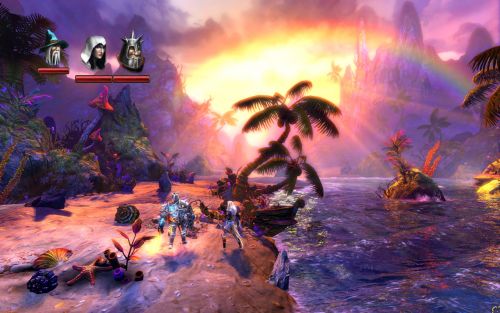
Not quite a double rainbow, but no less impressive
The campaign mode allows each player to play as one of the three heroes, swapping out who plays the third in the case of just two players, as they venture across the lands. Teamwork is, of course, the key as the puzzles that seemingly had only one possible solution when playing single player now have a variety of approaches. I initially played through several of the game’s levels solo and then with a friend and was struck by how different the solutions were to the same conundrum. Playing alone, I might have to impale a box on a swinging spiked pendulum with the wizard and then grapple across using the thief. In co-op, though, I simply create a plank and levitate it across a gap with my partner riding it surfer style, and he then flicked a switch to raise a platform for me to use. In addition to puzzle solving, there are a good number of collectibles to gather, both in the form of experience orbs and game artwork or poems that reveal some of the back-story, and many of these are much easier to get when playing with a friend or two.
For the game’s Unlimited mode, restrictions are removed and each player is free to use any of the three characters, meaning you could be running around with three wizards conjuring up all manner of boxes and planks to overcome obstacles. While the campaign mode feels more like an adventure platformer, Unlimited has more of an arcade feel to it. Should a player succumb to one of the game’s many traps, or be slain by a terrible foe, the remaining player(s) has but to get to the next checkpoint (or backtrack to the previous one) in order to revive him or her. The same rule applies in the campaign co-op, but whereas the campaign’s revival of a player means the return of a, sometimes, necessary third character, the revival of a player in Unlimited means he or she just joins the fray once more. It becomes less focused on how to work as a team to ensure no man (or woman) gets left behind, and more about ensuring at least one person survives to the next checkpoint. It’s a great addition and definitely allows for more replayability.

You may catch yourself wondering from time to time, "who would put a device like that in a place like this?"
The game has two noticeable flaws: one that pertains to the game as a whole, and one that is co-op specific. Taking a page from Batman: Arkham Asylum, Trine 2’s boss fights are notably less than inspired, as the same formula and strategy, with only a few small adjustments, are applied to almost all of the major enemies you encounter with the exception of the final one. All of that achievement you and your friends felt for overcoming a particularly devious puzzle turns a bit sour when you’re faced with the same dumb boss (slightly reskinned) doing the same dumb thing and dying the same dumb way. From a co-op perspective, the inclusion of online co-op was a feature the first game sorely needed, but it does present a situation when it comes to level progression and player location. Local players are semi-screen bound in the sense that if one player gets too far ahead/offscreen, they are immediately teleported back to the lagging player. For online co-op, should a player fall or get left behind, they are teleported to the leading player once that player reaches certain preset locations, typically an enemy encounter. This means that players could miss out on entire portions of the level, or that players have to backtrack (if they can) to get the player that fell behind. While we may not always like those “everybody stand on this switch to open the door” type of mechanics, they do help to alleviate this particular issue.
The original Trine provided a very solid co-op experience that had a few problems, e.g., lack of online co-op, which kept it from being truly great. The sequel has fixed those problems and provided even more ways to get the most out of the experience as a whole. Trine 2, then, is a perfect example of what so many sequels should be – an improvement on a good formula, not a retooling of the entire system.
Note: This review is based on the PC version of the game.
Verdict
Co-Op Score
Overall
The Co-Op Experience: A side-scrolling puzzle-platforming game featuring up to three players working together to complete the campaign.
Co-Optimus game reviews focus on the cooperative experience of a game, our final score graphic represents this experience along with an average score for the game overall. For an explanation of our scores please check our Review Score Explanation Guide.